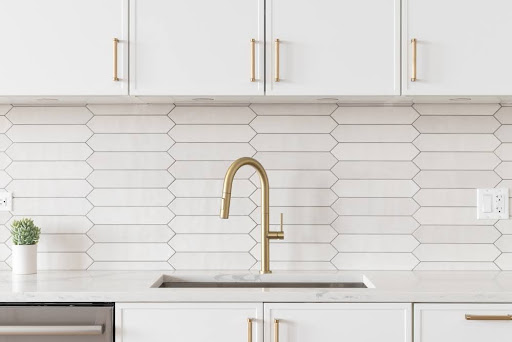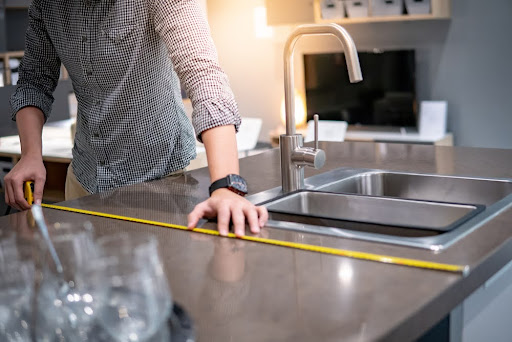Replacing your kitchen countertops is an exciting upgrade, but it’s crucial to get accurate measurements before selecting the perfect surface. Whether you’re budgeting for the project or providing dimensions for an estimate, knowing how to measure kitchen countertops correctly will save time and money while ensuring a seamless installation.
Tools You’ll Need
Before getting started, gather the necessary tools:
- Measuring tape (preferably a metal one for accuracy)
- Pencil and paper (or a digital note-taking device)
- Calculator
- Straightedge or level (for checking evenness)
SCHEDULE YOUR FREE CONSULTATION
How to Measure Kitchen Countertops in 7 Steps
Follow these steps to obtain as accurate dimensions as possible for your kitchen makeover. Taking pictures can also be very helpful.
1. Measure the Countertop Length
Start by measuring the total length of your existing countertops. Place the measuring tape along the back edge, running it from one end to the other. If you have an L-shaped or U-shaped kitchen, break the measurements into sections and note each segment separately.
2. Measure the Countertop Depth
Depth is the distance from the front edge of the countertop to the wall or backsplash. Standard kitchen countertops are 25 ½” deep, give or take a ½” depending on the material. If you add an overhang for seating, measurements typically extend to 36”, but anything beyond that may require additional support.
3. Measure the Countertop Thickness
Countertop thickness varies based on the material:
- Stone, like quartz or granite, is 3 cm (approximately 1 ¼”) thick
- Laminate or solid surface is closer to 1 ½” thick
Important note: if you’re replacing a laminate top with stone, you may need a ¼” buildup between the cabinets and the new surface, especially if you’re keeping an existing backsplash.
Thinking about new cabinets, too? Check out this cabinet design guide >>
4. Account for Cutouts
If your kitchen has a sink, cooktop, or other cutouts, be sure to measure those dimensions accurately. Measure the width and depth of each cutout, noting its position relative to the countertop edges.
If you’re replacing a sink, ensure that your new countertop accommodates the size and shape of the new fixture.
5. Consider Backsplash Dimensions
Standard backsplashes are 4” tall, but full-height backsplashes (extending to the bottom of the cabinets) are increasingly popular. If you plan to replace or add a backsplash, include those measurements.

6. Double-Check Your Measurements
Accuracy is key! Go over each measurement again to confirm its precision. If you’re unsure about any figures, it’s best to overestimate slightly, as contractors can typically trim materials down if needed.
7. Calculate the Total Square Footage
Most countertops are priced per square foot, so calculate the area based on your measurements:
- Multiply the length by the depth for each section.
- Add the areas of all sections together.
- If your countertops have angled or curved sections, break them into smaller rectangles or triangles and calculate accordingly.
When to Involve a Professional
DIY measurements are needed for project estimation, but your contractor should verify them during the templating process. It’s always best to have a professional triple-check your measurements before finalizing your order.
Ready to Upgrade Your Kitchen Countertops?
Accurate measurements are the first step toward a beautiful kitchen transformation. If you’re ready to get started on the next step and make your selections, get in touch with Northern Building Supply.
We offer high-quality countertop materials from Cambria and other leading brands, plus expert kitchen design services to ensure you achieve your dream outcome.

